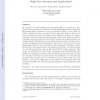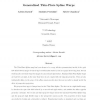124
click to vote
IANDC
2011
14 years 7 months ago
2011
We introduce the class of Rigid Tree Automata (RTA), an extension of standard bottom-up automata on ranked trees with distinguished states called rigid. Rigid states define a res...
107
Voted
CORR
2011
Springer
14 years 7 months ago
2011
Springer
In this paper, we develop new methods for the analysis of decentralized control systems and we apply them to formation control problems. The basic set-up consists of a system with...
116
Voted
CVPR
2011
IEEE
14 years 8 months ago
2011
IEEE
We present a novel probabilistic framework for rigid tracking and segmentation of shapes observed from multiple cameras. Most existing methods have focused on solving each of thes...
INFOCOM
2010
IEEE
14 years 10 months ago
2010
IEEE
A fundamental problem in wireless ad
88
Voted
IJCV
2010
14 years 11 months ago
2010
The Thin-Plate Spline warp has been shown to be a very effective parameterized model of the optic flow field between images of various types of deformable surfaces, such as a p...
IJCV
2002
15 years 9 days ago
2002
In this paper we explore a multiple hypothesis approach to estimating rigid motion from a moving stereo rig. More precisely, we introduce the use of Gaussian mixtures to model cor...
95
Voted
ICRA
2002
IEEE
15 years 5 months ago
2002
IEEE
We develop a method for generating smooth trajectories for a set of mobile robots. Given two end configurations, by tuning one parameter, the user can choose an interpolating tra...


